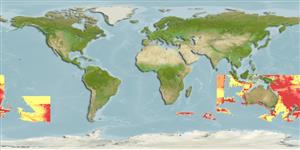Teleostei (teleosts) >
Gadiformes (Cods) >
Macrouridae (Grenadiers or rattails)
Etymology: Ventrifossa: Latin, venter, ventris = belly + Latin, fosa = pit (Ref. 45335).
Eponymy: Dr John Richard Paxton (d: 1938) is an American-born Australian ichthyologist. [...] (Ref. 128868), visit book page.
More on authors: Iwamoto & Williams.
Environment: milieu / climate zone / depth range / distribution range
Ecology
Marine; bathypelagic; depth range 878 - 1053 m (Ref. 35909). Deep-water
Western Central Pacific: Australia, New Caledonia, Chesterfield and Bellona Plateau.
Size / Weight / Age
Maturity: Lm ? range ? - ? cm
Max length : 48.0 cm TL male/unsexed; (Ref. 35909)
Short description
Identification keys | Morphology | Morphometrics
Dorsal spines (total): 2. pelvic fin rays 9-10, fins all black; median nasal streak faint or absent; chin barbel slender, moderately long, 24-35% of head length; outer premaxillary teeth small, scarcely enlarged; darker dorsum not strongly demarcated from paler lateral and ventral parts of trunk and tail; suborbital shelf broad, without anterior constriction, almost entirely black.
A benthic species found on the continental slope (Ref. 75154).
Life cycle and mating behavior
Maturity | Reproduction | Spawning | Eggs | Fecundity | Larvae
Iwamoto, T. and A. Williams, 1999. Grenadiers (Pisces, Gadiformes) from the continental slope of western and northwestern Australia. Proc. Calif. Acad. Sci. 51(3):105-243. (Ref. 35909)
IUCN Red List Status (Ref. 130435: Version 2024-1)
Threat to humans
Harmless
Human uses
Fisheries: bycatch
Tools
Special reports
Download XML
Internet sources
Estimates based on models
Preferred temperature (Ref.
123201): 3.3 - 7.2, mean 5 °C (based on 120 cells).
Phylogenetic diversity index (Ref.
82804): PD
50 = 0.5000 [Uniqueness, from 0.5 = low to 2.0 = high].
Bayesian length-weight: a=0.00214 (0.00109 - 0.00421), b=3.20 (3.03 - 3.37), in cm total length, based on LWR estimates for this (Sub)family-body shape (Ref.
93245).
Trophic level (Ref.
69278): 3.8 ±0.5 se; based on size and trophs of closest relatives
Resilience (Ref.
120179): Low, minimum population doubling time 4.5 - 14 years (Preliminary K or Fecundity.).
Fishing Vulnerability (Ref.
59153): Moderate vulnerability (38 of 100).
